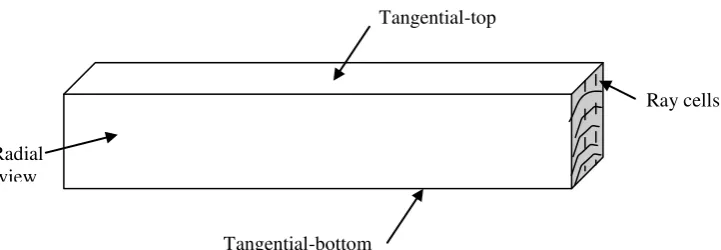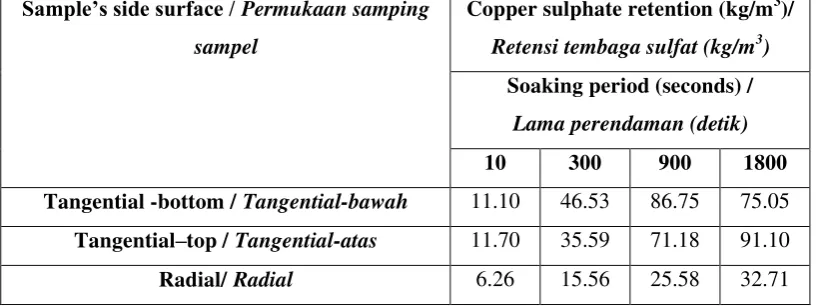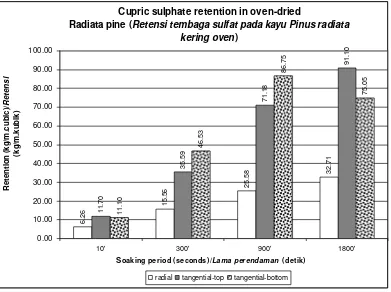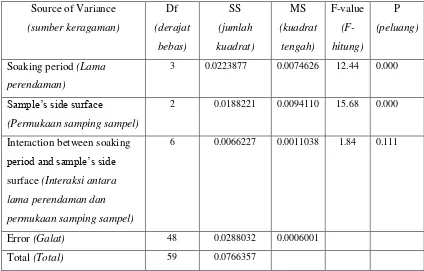THE EFFECT OF SOAKING PERIOD AND SAMPLE’S SIDE SURFACES ON COPPER SULPHATE RETENTION IN OVEN-DRIED RADIATA
PINE1
(Pengaruh Lama Perendaman dan Bidang Permukaan Samping Contoh Uji Terhadap Retensi Tembaga Sulfat pada Kayu Pinus RadiataKering Oven)
By/Oleh :
Karnita Yuniarti2 & Jeff Hann3
ABSTRAK
Penelitian bertujuan untuk menganalisa pengaruh lama perendaman dalam larutan pengawet tembaga sulfat dan bidang permukaan samping yang terekspos terhadap nilai retensi tembaga sulfat pada kayu Pinus radiata D.Donn yang dikeringkan dengan oven. Hasil penelitian menunjukkan nilai retensi tembaga sulfat dipengaruhi dengan sangat nyata oleh faktor waktu rendam dan bidang permukaan samping contoh uji yang terekspos selama proses rendaman. Nilai retensi tembaga sulfat tertinggi (91,10 kg/m3) dihasilkan melalui proses rendaman selama 1800 detik (30 menit) dengan bidang permukaan samping contoh uji yang terekspos adalah tangensial atas. Perendaman selama 10 detik dengan membiarkan permukaan samping radial contoh uji yang terekspos menghasilkan nilai retensi tembaga sulfat terendah (6,26 kg/m3).
Kata kunci : bidang permukaan samping, lama perendaman, tembaga sulfat, Pinus radiata
1
Makalah hasil penelitian untuk bidang pengawetan kayu yang ditugaskan pada saat pelaksanaan studi S2 di University of Melbourne, Australia di bawah bimbingan Dr. Jeff Hann (Research paper assigned for wood preservation course taken during the master program and supervised by Dr. Jeff Hann at University of Melbourne)
2
Calon peneliti pada Pusat Litbang Hasil Hutan, Bogor (Yunior researcher at Centre for Forest Product Research and Development, Bogor)
3
ABSTRACT
The experiment aimed to investigate the influence of soaking period and the exposed side surface of the samples on the retention of copper sulphate in oven-dried Pinus radiata D.Donn. The result obtained showed that the retention value was significantly affected by soaking period and by which side-surface of Radiata pine samples was exposed to preservatives during treatment. Soaking the samples with their tangential-top side-surface exposed during treatment for 1800 seconds (15 minutes) gave the highest value of copper sulphate retention (91.10 kg/m3). On the other hand, soaking the samples with their radial side-surface exposed during treatment resulted in the lowest value of copper sulphate retention (6.26 kg/m3) in oven-dried Pinus radiata.
Key words : side surface, soaking period, copper sulphate, Pinus radiata
I. INTRODUCTION
Formerly known as a native species to southern California (USA) (Scott 1960), Pinus radiata D.Donn has now become an important industrial tree species in other places such as New Zealand and Australia. Nevertheless, Radiata pine is not a high natural durable species. It was recorded susceptible to the attack of sap-stain fungi, Annobium punctatum and other boring insects (Lewis 1966).
protection belt around the heartwood, thus could help extending the service life of a particular species to 30 years or more.
The uptake of preservatives is affected by several factors, such as the timber condition prior to treatment process (Kollmann and Côté 1968). According to Bateson (1946), Usta and Guray (2000) and Waterson (1997) drying timber before treatment could increase the treatability of timber. This is due to the additional void spaces available inside the wood as the result of drying process. However, the possibility of pit aspiration to occur during drying process, especially kiln drying, should be also recognized as this phenomenon could then prevent any liquid to transport within the wood. Messner et al. (2002) reported that dried Sitka spruce wood has permeability of one to five percent lower than the green timber due to this pit aspiration resulting from the kiln drying process.
Furthermore, which part of the timber exposed to the treatment process is also assumed able to influence the uptake of preservative by the wood. Cassens et al. (1995) stated that the treatability of wood varies with grain direction. The penetration ratio between end and side grain is about 15 to 1 for oil-based preservatives and 20 to 1 for water-borne preservatives (Cassens et al. 1995). According to Hunt and Garratt (1938) the penetration of preservatives through the side-grain was an important issue for long pieces of wood that were inadequately treated by end-grain-penetration alone to achieve sufficient treatment.
soaking process. The success of wood treatment with this method is affected by, among others, the period of soaking. Muga (2001) found that Radiata pine soaked in furfuryl alcohol resin for 10 or 20 minutes absorbed the resin greater than when it was soaked for 1 or 5 minutes in the same resin solution.
The preservative types used seemed also affecting the treatment of wood with soaking process. Many experiments indicated that longer soaking period of wood in water-borne preservative solution commonly resulted in larger amount of preservatives absorbed by the wood (Abdurrohim and Ginoga 1993; Yetty and Barly 1990; Barly and Permadi, 1987; Abdurrohim et al. 1987; Barly and Abdurrohim 1986).
The experiment aimed to investigate the effect of applying different soaking period and exposing different side surfaces on the retention of copper sulphate in oven-dried Radiata pine.
II. METHODOLOGY
A. Material and Equipment
B. Site and Time
The experiment was carried out at School of Forest and Ecosystem Science, Institute of Land and Food Resources, University of Melbourne-Creswick, during the period of May-July 2003.
C. Procedure
1. Sample preparation and drying process
As can be seen in Figure 1, each sample had 4 side surfaces (2 radial and 2 tangential faces). However, since the two radial faces were difficult to be differentiated from one another, then it was decided to use only 1 radial side. Thus, for this experiment, there were only 3 side surfaces used which were tangential top, tangential bottom and radial. The 60 samples were divided evenly into 3 groups based upon which side surface would be left unsealed. In order to properly asses the ability of a specific side surface in absorbing the preservative, for example the tangential-top surface, the remaining surfaces (tangential-bottom and radial surfaces) and end-surface of each sample were sealed thoroughly with silicone gel. With this sealing process, it was expected that the effect of preservative penetration through the surfaces other than the unsealed surface could be eliminated.
Figure 1. The determination of side surfaces of Radiata pine samples (tangential-top, tangential-bottom, and radial)
Gambar 1. Penandaan permukaan samping pada contoh uji kayu Pinus radiata (tangential-atas, tangensial-bawah, dan radial)
2. Soaking process
The chemical used for this experiment was 2% Copper sulphate. The soaking process was designed in 4 different times: 10 seconds, 5 minutes, 15 minutes and 30 minutes. Samples from each side-surface group were divided equally into these 4 different soaking times. Those samples were weighed before and after each soaking process.
3. Data Collection and Analysis
The data collected in this experiment were samples dimension, initial weight prior to treatment and final weight of samples after the soaking process. These data were used to calculate the retention value using the formula below: ;
Tangential-bottom
Tangential-top
Ray cells Radial
Retention (kg/m3)= (final weight–initial weight) (kg) x solution strength (% w/w) Sample dimension (m3)
The data on retention of the Copper sulphate in Radiata pine were analyzed using analysis of variance (ANOVA) test provided in Minitab 11 software. The data was set as two-way experimental design with the soaking period as the first factor (A) consisting of 4 levels (10 seconds, 5 minutes, 15 minutes and 30 minutes) and the side surfaces of sample as the second factor (B) consisting of 3 levels (radial-top, radial-bottom and tangential). The experiment model was as follow (Gasperz 1991) :
Yijk = m + Aik + Bjk + (AB)ijk + Eijk i = 1, 2, 3, 4 j = 1, 2, 3 k = 1,2,3,4,5
Where :
Yijk = Retention of copper sulphate on side surface-j of sample-k previously soaked for – i period
m = mean of population
Aik = influence of soaking period-i on copper sulphate retention of sample-k Bjk = influence of side surface –j on copper sulphate retention of sample-k ABijk = influence of interaction between between soaking period-i (Aik) and side
Further least significant difference test (Fisher’s test) was carried out
following the ANOVA test if the ANOVA test above gave significant result. The
Fisher’s test was carried out using Minitab 11 software in order to examine any
significant difference of the mean values between and within the observed factors
(sample’s side surface, soaking period and interaction of both factors).
III. RESULTS AND DISCUSSION
Table 1 and Figure 2 showed the retention of copper sulphate in oven-dried Radiata pine. Briefly, it can be seen that soaking period did have an effect on the value of copper-sulphate retention by the samples. In general, as can be seen in Figure 2, as the soaking period increased, so did the copper sulphate retention. Thus, the shortest soaking period (10 seconds) gave the lowest value of copper sulphate retention on all side surfaces.
Most researchers found that lengthening the soaking period of wood in a solution of chemical preservatives could improve the absorption of the chemical itself by the wood, which in this context was indicated by highest retention value of the chemical in the wood (Muga 2001; Abdurrohim and Ginoga 1993; Yetty and Barly 1990; Barly and Permadi, 1987; Abdurrohim et al. 1987; Barly and Abdurrohim 1986). This is understandable as longer soaking period could accommodate a long interaction between the wood and the chemical being introduced.
part of the wood is being introduced to the chemicals and/or the type of the chemicals used. As can be seen in Table 1, the longest soaking period (1800 seconds / 30 minutes) apparently did not result in the highest retention of copper sulphate in Radiata pine wood when only its tangential-bottom surface exposed to the preservatives solution.
[image:9.595.99.508.323.476.2]Table 1. Average value of copper sulphate retention (kg/m3) in oven-dried Radiata pine
Tabel 1. Nilai rata-rata retensi tembaga sulfat (kg/m3) pada kayu Pinus radiata kering oven
Sample’s side surface / Permukaan samping sampel
Copper sulphate retention (kg/m3)/
Retensi tembaga sulfat (kg/m3)
Soaking period (seconds) /
Lama perendaman (detik)
10 300 900 1800
Tangential -bottom / Tangential-bawah 11.10 46.53 86.75 75.05
Tangential–top / Tangential-atas 11.70 35.59 71.18 91.10
Cupric sulphate retention in oven-dried
Radiata pine (Retensi tembaga sulfat pada kayu Pinus radiata
kering oven)
6 .2 6 1 5 .5 6 2 5 .5
8 32
.7 1 1 1 .7 0 3 5 .5 9 7 1 .1 8 9 1 .1 0 1 1 .1 0 4 6 .5 3 8 6 .7 5 7 5 .0 5 0.00 10.00 20.00 30.00 40.00 50.00 60.00 70.00 80.00 90.00 100.00
10' 300' 900' 1800'
Soaking period (seconds)/Lama perendaman (detik)
R e te n ti o n (k g /m .c u b ic )/ R e te n s i (k g /m .k u b ik )
radial tangential-top tangential-bottom
Figure 2. Retention of copper sulphate impregnated on different side surfaces of Radiata pine
Gambar 2. Retensi tembaga sulfat yang diimpregnasikan pada permukaan samping kayu Pinus radiata
[image:10.595.104.495.101.393.2]Table 2. The-2-way ANOVA (Analysis of variance) result for analyzing the effect of soaking period and sample’s surface on copper-sulphate retention in oven-dried Radiata pine
Tabel 2. Uji ANOVA(Analisa keragaman) untuk pengujian pengaruh lama perendaman dan permukaan samping sampel terhadap retensi tembaga sulfat pada kayu Pinus radiata kering oven
Source of Variance
(sumber keragaman) Df (derajat bebas) SS (jumlah kuadrat) MS (kuadrat tengah) F-value (F-hitung) P (peluang)
Soaking period (Lama
perendaman)
3 0.0223877 0.0074626 12.44 0.000
Sample’s side surface
(Permukaan samping sampel)
2 0.0188221 0.0094110 15.68 0.000
Interaction between soaking
period and sample’s side
surface (Interaksi antara
lama perendaman dan
permukaan samping sampel)
6 0.0066227 0.0011038 1.84 0.111
Error (Galat) 48 0.0288032 0.0006001 Total (Total) 59 0.0766357
Remarks/Keterangan : * = significant effect; Df= degree of freedom; SS= Sum of square; MS=Mean of square; P=Probability
and Walker 1993). Nonetheless, this preliminary assumption needs more experiments to validate its accuracy.
It also can be seen in Table 1 and Figure 2 that the retention of copper sulphate impregnated from tangential-bottom surface of the sample was higher than that from tangential–top surface of the sample for soaking periods of 300 seconds and 900 seconds. Further test (Appendix 1) confirmed that significant difference in copper sulphate retention was found between samples with their tangential top and bottom exposed to preservatives during treatment.
IV. CONCLUSION AND RECOMMENDATION
1. The retention value of copper sulphate in oven-dried Radiata pine was significantly affected by soaking period and by which side-surface was exposed to preservative solution.
2. The longest soaking period (1800 seconds) resulted in highest retention of copper sulphate, except for samples with its tangential-bottom surface exposed during treatment process.
3. Samples with their tangential surfaces exposed to preservative solution had higher retention of copper sulphate than those with their radial surface exposed.
4. The interaction between soaking period and which side-surface was exposed to preservative solution was found to have less significant effect on the retention value of copper sulphate in oven-dried Radiata pine. 5. Further and detailed experiments are required to investigate the exact
causes behind the results obtained from this experiment.
ACKNOWLEDGEMENT
BIBLIOGRAPHIES
Abdurrohim, S. and B. Ginoga. 1993. Cold soaking treatment of two wood species of moulding products using BFCA preservatives. Forest Product Research Journal Vol.11 (8) : 338-341. Forest Products and Socio-Economic Research and Development Center. Bogor.
Abdurrohim, S.; A. Martawijaya and P. Permadi. 1987. Cold soaking treatment of fifteen wood species from Irian Jaya. Forest Products Research Journal Vol. 4 (4) : 26-34. Forest Products Research and Development Center. Bogor. Barly and S. Abdurrohim. 1986. Cold soaking treatment of Coconut wood. Forest
Products Research Journal Vol. 3 (2) : 9-13. Forest Products Research and Development Center. Bogor.
Barly and P. Permadi. 1987. Soaking treatment of two Meranti wood species. Forest Products Research Journal Vol. 4 (4) : 4-7. Forest Products Research and Development Center. Bogor.
Bateson, R.G. 1946. Timber Drying. Crosby Lockwood & Son, Ltd., London. Brennan, G.K. 1993. Preservation of round timber products. Report No. 21, Wood
Utilisation Research Centre, Dept. of Conservation and Land Management. Harvey, Western Australia.
Cassens, D.L., W.C. Feist, R.C. De Groot, and B.R. Johnson. 1995. Selection and use of preservative-treated wood. Forest Products Society. Madison, USA. Hunt, G.M. and G.A. Garrat. 1938. Wood preservation. McGraw-Hill Book
Company, Inc. New York, USA.
Kollmann, F.F.P. and W.A. Côté, Jr. 1968. Principles of wood science and technology I : Solid wood. Springer-Verlag. Berlin.
Langrish, T.A.G. & Walker, J.C.F. 1993. Primary wood processing: principles and practices. Chapman & Hall, London.
Lewis, N.B. 1966. The Radiata pine industry of the south east. The Radiata Pine Association of Australia. Australia.
Muga, M.O. 2001. Mechanical properties of wood following microwave and resin modification. MSc.Thesis. School of Forestry, ILFR, University of
Melbourne, Melbourne.
Scott, C.W. 1960. Pinus radiata. Food and Agriculture Organization of The United Nations, Rome, Italia.
Usta, I. and Guray, A. 2000. Comparing of the moisture reduction of Sitka spruce and Oriental spruces by kiln drying. Journal of Qafqaz University, vol.Fall, no.6, pp: 123-130.
Waterson, G.C. (ed). 1997. Australian timber seasoning manual. Australasian Furnishing Research and Development Institute Limited, Launceston, Tasmania.
Appendix 1. Least Significant Difference (LSD) Fisher-s test to compare retention value between soaking period groups and side surface groups
1. One-Way Analysis of Variance : Comparison between soaking period Groups
1. Analisa keragaman 1 arah : Perbandingan antar grup berdasarkan lama perendaman
Analysis of Variance for retention
Source DF SS MS F P soaking 3 0.022388 0.007463 7.70 0.000 Error 56 0.054248 0.000969
Total 59 0.076636
Fisher's pairwise comparisons
Family error rate = 0.199 Individual error rate = 0.0500
Critical value = 2.003
Intervals for (column level mean) - (row level mean)
0.17 5.00 15.00
5.00 -0.03558 0.00994
15.00 -0.06400 -0.05118 -0.01847 -0.00565
2. One-Way Analysis of Variance : Comparison between side-surface groups
2. Analisa keragaman 1 arah : Perbandingan antar grup berdasarkan permukaan samping yang terkena
larutan pengawet
Analysis of Variance for retention
Source DF SS MS F P side sur 2 0.01882 0.00941 9.28 0.000 Error 57 0.05781 0.00101
Total 59 0.07664
Fisher's pairwise comparisons
Family error rate = 0.121 Individual error rate = 0.0500
Critical value = 2.002
Intervals for (column level mean) - (row level mean)
1 2
2 -0.02540 0.01493
3 0.01452 0.01975 0.05484 0.06008
Remarks :



